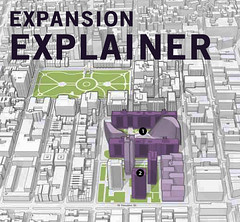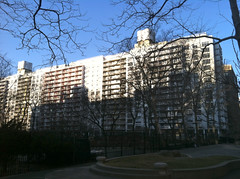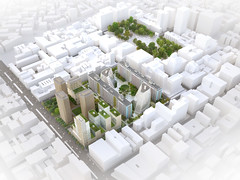To conclude our week-long look at the impacts of N.Y.U.’s expansion plans, The Local examines the concerns surrounding loss of light under the proposed development.
How will the new buildings proposed on the two superblocks south of Washington Square Park affect sunlight in the area?
There’s no getting around it, the new buildings mean less light. The LaGuardia and Mercer buildings planned for the north block will cast shadows on the two Washington Square Village buildings. More controversially, the proposed Bleecker building on the south block will cast a shadow that likely means an end to the LaGuardia Corner Gardens, located in front of the Morton Williams supermarket on a strip of property that belongs to the Transportation Department. The university notes that the alignment of the LaGuardia and Mercer buildings would make the block resemble the dimensions of the city’s grid pattern – “not an unusual New York City condition,” per William Haas, the university’s director of planning.
What has N.Y.U. done to minimize the loss of light?
According to the university, the different heights of the LaGuardia and Mercer buildings — eight stories and 14 stories respectively —are meant to reflect the transition from the low-rise buildings in the western part of the neighborhood to the taller ones around Broadway. The façades of the buildings would reflect light and their curves are meant to minimize shadows in the newly renovated green space proposed for the north block, said Mr. Haas.
What could be done to reduce shadows and save the garden?
According to N.Y.U., it would take major rethinking of the proposal. The public school facilities planned for the base of the Bleecker building would on their own enshroud the garden, and it’s highly unlikely that the building could be reduced enough on that plot to satisfy both the university and opponents. In its Environmental Impact Statement, N.Y.U. rejects two alternate locations for the Bleecker building further south or east of its proposed footprint on the south block because they would encroach on landmarked land in University Village and also cast shadows on the garden.
So is the garden doomed?
If the plan is approved in its current form, yes. During and after the 39-month construction period of the Bleecker building, temporary staging structures as well as around five hours of new shadows from the completed building would make it impossible for the garden’s sunlight-dependent plants to survive. The university’s impact statement adds, “Although the remaining sunlight could support shade-tolerant species, the proposed project’s incremental shadows would jeopardize the viability of shade-intolerant species.”
Are there any viable locations for the garden’s replacement?
The university hasn’t found one yet, but Vice President Alicia Hurley said she is still looking. Sara Jones, the chairwoman of LaGuardia Corner Gardens, told a different story. “No one has ever said to us, ‘Oh we’ll find you a better place,’” she said. “How do you replace something that’s been there for 30 years? How do you replace my apple and peach tree?”
What is N.Y.U.’s reason for choosing to build on this location?
The university justifies the loss of the garden by emphasizing the need for students to be close to Washington Square Park, as well as the public school in the Bleecker building. The school is an amenity that the university said it included in response to community needs. The garden “is not a defining feature of the neighborhood with respect to uniqueness or overall characterization of the area, and the property could continue as community landscaped open space,” the university said in its impact statement.
Ms. Jones countered that the garden — tended by roughly 50 active members and open to the public most nights and weekends — is an important resource for the neighborhood. The garden hosts educational programs for public schools and children, many of whom she said have never seen an apple tree before. “In this area, there isn’t anything like that. In the East Village there are gardens, but here, no,” she said.
What are the benefits to all this construction?
N.Y.U. touts the newly renovated green space that will come with the two new buildings on the northern block, which the university believes is currently uninviting to pedestrians. Opponents blame the university for allowing the space to devolve into its unwelcoming state, and scoff at the notion that two buildings are necessary to make it more open to the public. And they wonder whether the project will drive up rents and force longstanding local businesses to close. Supporters of the expansion tout the jobs that come with development on such a scale. Just today, the Greenwich Village-Chelsea Chamber of Commerce released a survey that found that 75 out of 110 Greenwich Village merchants believed that their businesses would grow as the university expands.







